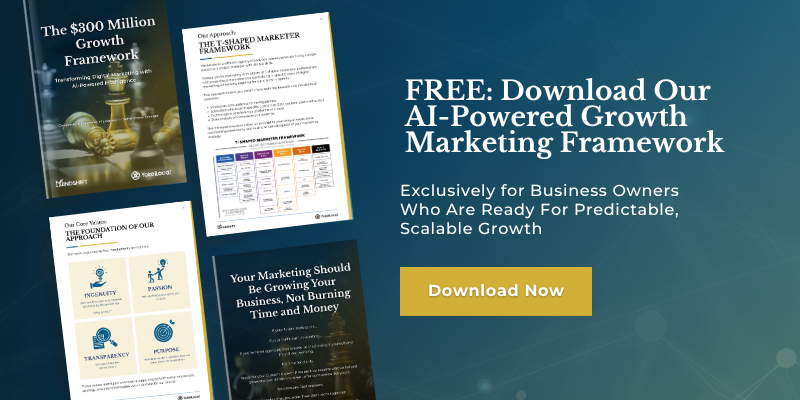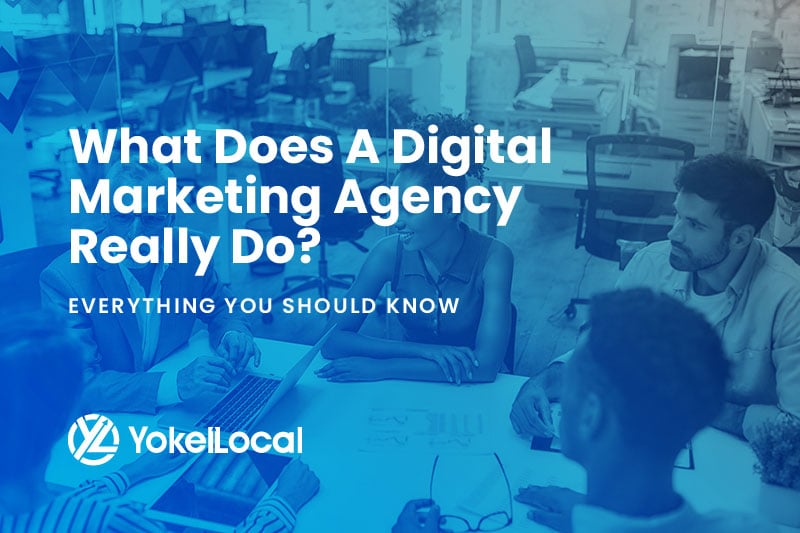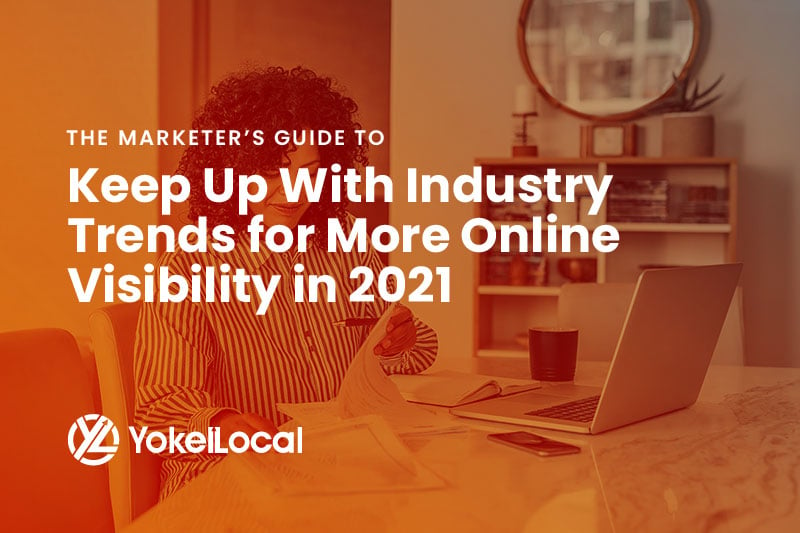Whether you’ve been in business for years or are relatively new to the business world, you’ve likely seen the environment change a great deal. The online arena, what was once thought to be a passing fad, has gone beyond our wildest imaginations and taken over every aspect of business and life.
Technology has become an integral part of our daily routines, and while you may have gotten the bulk of your business from word-of-mouth, networking, or some type of traditional advertising in the past, the landscape has now changed. Some businesses have already chosen to adapt to the times. Those that haven’t will find themselves out of business very soon.
Rather than stick your head in the sand and wait until you begin losing business to change, you need to embrace technology and the new world it has ushered us into. In order to do that, you need to understand what’s happening and figure out how to use it to your advantage.
Below, you’ll learn important statistics in each of the areas surrounding our digital landscape. Take a look and see which of these you can put to use in your company.
SEO Statistics
SEO stands for Search Engine Optimization and refers to the ability of search engines to connect your website with people looking for a solution to a specific problem. In order to do this, you must place specific keywords throughout your website. For example, if you offer party rentals in your town, you will determine what keywords potential customers are searching for when they look online, and then create your messaging around those keywords. These might include things like “birthday party,” “wedding rental,” “special occasions,” and even the town that you live in.
When you’ve used the proper keywords, search engines are able to connect your potential customer to your website so they can learn more about the products and services you offer.
Let’s take a look at some of the statistics you need to know around SEO:
- 80% of users ignore paid search results, clicking only on organic listings. (IMPACT)
- Search engines drive 300% more traffic to sites than social media. (IMPACT)
- Each second, Google receives over 77,000 searches. (Internet Live Stats)
- 75% of people never scroll past the first page of search engines. (IMPACT)
- Google is responsible for 94% of total organic traffic. (IMPACT)
Takeaway
It’s obvious that Google is a big player in the SEO game and you’ll want to stay abreast of their guidelines (as well as other search engines like Yelp and YouTube) so you can adhere to them, be found on the first page, and get noticed by as many potential customers as possible.
3 Exercises Every Marketer Should Do to Increase WEbsite Traffic
Content Marketing Statistics
Content marketing involves creating and distributing useful, relevant, and consistent content that speaks to your potential customer’s problems and provides them with information and solutions. Content marketing is a noninvasive way of getting in front of your ideal client, becoming an expert in their eyes, and staying front-of-mind until they are ready to purchase. In essence, you become less of a talking head screaming about sales and more of a resource.
- 72% of online marketers say that content creation is their most useful SEO tactic. (Marketing Profs)
- Content marketing costs 62% less than traditional marketing yet it generates about 3 times as many leads. (Demand Metric)
- Only 23% of CMOs feel they are producing the right information for the right audience, and delivering it at the right time and in the correct format. (Marketing Profs)
- Over ¾ of internet users say they read blogs regularly. (Quoracreative, 2019)
- The most common measurement of success for content marketing programs is Total Sales. (HubSpot)
Takeaway
Content marketing should play a large role in your marketing and advertising strategy. When you’ve crafted a successful content strategy and carried it out properly, your ROI will be high and your sales will increase.
Social Media Statistics
While you’ve probably been using it for a while, it’s important to understand what social media is and what purpose it serves, before we discuss important statistics.
Social media refers to digital platforms that allow you to connect with and share content with consumers. There are a variety of different platforms (and more are added every day) including Facebook, Instagram, Twitter, LinkedIn, YouTube, and many others. The content you’ll share depends on which platform you’re using and who your specific audience is.
- Social media has become the most popular content marketing tactic reported by 90% of B2C businesses. (Content Marketing Institute)
- Globally, there are over 2.38 billion monthly active users on Facebook. (HubSpot)
- According to Facebook, the platform reaches over 60% of internet users. (HubSpot)
- In 2020, 75.3% of U.S. businesses will use Instagram. (HubSpot)
- 59% of Americans believe that customer service through social media has made it easier to get their questions answered and issues resolved. (HubSpot)
- Blog posts longer than 1,500 words receive 68.1% more Tweets and 22.6% more Facebook likes. (Serpwatch.io)
Takeaway
Love it or hate it, social media is a valuable tool for marketing your business. Just remember that the point of social media marketing is to be accessible to your customer and create a conversation, it’s not just a place to dump your asks for business and run. And despite our short attention spans, creating longer content will increase your chances of being seen and heard.
Mobile Marketing Statistics
Mobile marketing refers to reaching existing and potential customers through mobile means. This includes smartphones, tablets, and any other mobile devices. Consider how many times you’ve done a search for a restaurant or store while you’re already in your car or out and about.
- 51% of smartphone users have found new brands or products while searching from their mobile device. (Lyfe Marketing)
- 87% of smartphone owners use a search engine daily. (Serpwatch.io)
- The average smartphone conversion rate is up by 64%. (Lyfe Marketing)
- 85% of mobile advertisers think they’re providing a positive experience; only 47% of users agree. (Business of Apps)
- 46% of Americans will check their smartphone before getting out of bed. (Serpwatch.io)
Takeaway
Consumers now have the power to search for the products and services they need, in the palm of their hand. In order to take advantage of this mobile marketplace, you’ll need to make sure that your website is optimized for mobile viewing, that your business is searchable by industry and by location, and that your marketing is attractive enough to stand out in a crowded world.
Video Marketing Statistics
Video marketing is used to promote and market your product or service to new and existing customers, increase engagement, and educate your customers. In order to make the most out of it, you need to know:
- Four out of five customers believe that demo videos of a product are helpful. (Serpwatch.io)
- 65% of senior executives navigate to a site after viewing a related YouTube video. (Serpwatch.io)
- 72% of businesses have seen improved conversion rates based off of videos. (Serpwatch.io)
- If you include video on your website, it is 53 times more likely to show up on the first page of search results. (Serpwatch.io)
- 70% of consumers have shared a branded video. (Serpwatch.io)
Takeaway
Video is an incredibly important aspect of your marketing. When creating videos, keep these things in mind:
- Include a logo, contact info, or some other type of branding in every video you create.
- Post your videos on YouTube even if you created them for another site.
- Include a call to action with your videos.
- Create helpful tutorials for your products that consumers can learn from.
Email Marketing Statistics
Email marketing is the use of email to contact new and existing clients, promote your business, build relationships, offer specials, and stay top-of-mind with consumers.
Since it’s totally paperless, email marketing is more affordable than direct mail and much better for the environment. In order to do it properly, here are a few statistics you need to know:
- 85% of U.S. retailers call email marketing one of their most effective methods of acquiring customers. (Lyfe Marketing)
- Email marketing has an average 4400% ROI. (Lyfe Marketing)
- Segmented email marketing campaigns can increase open rate by 14.65% when compared to non-segmented campaigns and list segmentation boosts click-through rate by 59.99%. (Lyfe Marketing)
- 86% of professionals prefer to use email when they communicate for business purposes. (Lyfe Marketing)
- 59% of consumers claim that their purchase decisions are influenced by marketing emails, and 50% said that they buy from a marketing email at least once a month. (Sales Cycle)
Takeaway
While everyone faces an avalanche of emails each morning when they open their inbox, some of them are making it through and influencing consumers to make a purchase. Email marketing is an effective, affordable way to communicate with your existing and potential customers. Just make sure that you follow the rules of the road and don’t get spammy.
Automated Nurturing: Best Practices for Great Email Campaigns
Lead Generation Statistics
Every business could use more customers… or at least better ones. If you aren’t using lead generation to attract new business, you should be. Inbound lead generation allows you to speak with consumers that have already shown interest in what you do, rather than making the dreaded cold calls that no one (especially not the consumer) enjoys.
- 62% of marketers see generating traffic and leads as their top challenge. (Serpwatch.io)
- 68% of B2B businesses acquire leads through strategic landing pages. (Serpwatch.io)
- Only 18% of marketers see high quality leads from outbound practices. (Serpwatch.io)
- 63% of consumers who ask for information about your business or products won't make a purchase for at least three months. (Marketing Donut, 2019)
- When businesses follow-up with online leads in under five minutes, those leads are nine times more likely to convert into customers. (Ziff Davis, 2019)
Takeaway
Inbound lead generation will help you attract more quality potential customers. However, it’s important to follow up quickly to show that you are eager to have them as a customer, and frequently to stay top-of-mind until they are ready to buy.
How to Find & Remove Conversion Roadblocks on Your Website
Sales Statistics
If you are marketing your business properly, your sales should be increasing. If they are not, you need to approach your marketing differently. Understanding sales statistics will help you know if you’re on the right track.
- 18% of salespeople don’t know what a CRM or Customer Relationship Management system is. (HubSpot)
- 75% of companies site closing more deals is their top sales priority. (HubSpot)
- 80% of sales are made by 20% of salespeople. (Zety, 2019)
- 65% of salespeople who use social selling fill their pipeline, compared to 47% of reps who do not.
- 52% of marketers say they provide salespeople with their best quality leads, while salespeople rank marketing-sourced leads last. (HubSpot)
Takeaway
Creating relationships will always be the most important part of marketing and sales. The sales people who embrace this and learn to do it properly, will always outsell those who rely on a marketing department to hand them qualified buyers.
Blogging Statistics
While people have been blogging as their own personal platform for years, many businesses now understand the importance of providing consistent content for their existing and potential customers. Blogs can answer questions that the audience may have, introduce solutions to problems, highlight specific products and services and share individual stories of these products in use, and much more. If you’re considering adding blogging to your marketing plan, here’s what you need to know:
- Companies that regularly blog receive 97% more links to their website. (Serpwatch.io)
- To attract the most traffic, use titles with 6-13 words. (Serpwatch.io)
- Business to Consumer companies that blog more than 11 times per month get more than 4x the number of leads of those who blog only 5 times per month. (Serpwatch.io)
- Marketers who prioritize blogging efforts are 13x more likely to see positive ROI. (HubSpot)
- Listicles are the most popular blog post format among business blogs. (HubSpot)
Takeaway
Despite all of the technology available to businesses these days, crafting a well-written blog that provides information and guidance for a consumer is still one of the best ways to attract customers and position you as an expert in their eyes. When you do this and stay top-of-mind by frequently releasing quality content, they’ll be more likely to purchase from you when they are ready.
Inspired by These Marketing Stats?
Today’s technology offers many opportunities to get your brand in front of consumers and influence them to purchase your products and services. Knowing these important statistics helps guide you to make the right marketing decisions for your business and figure out where to put your time and your energy for maximum digital marketing ROI.















